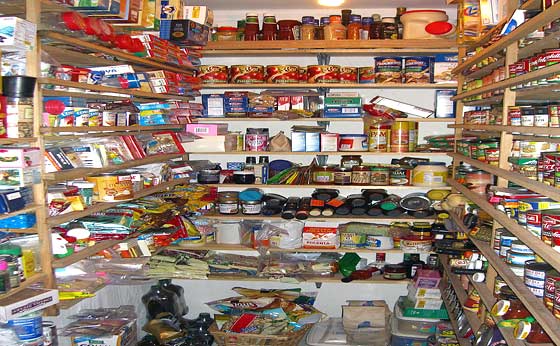Getting Started With Basic Food Storage Preps
Disruption to the food supply chain
A basic essential to survivalism is having enough food to eat and water to drink. In today’s modern world, we take it for granted that there will always be food on grocery store shelves, and there are many built-in assumptions with that thought process. Here are a few examples of what could disrupt the supply chain of having food readily available at grocery stores (most grocery stores have less than a 1-week supply on hand… even those with more than that will run out quickly during a panic ).
- trucking or transportation system breakdown (there are many scenarios)
- major regional disaster (hurricane, earthquake, war, terrorism, etc…)
- panic from pandemic
- economic collapse and resulting social chaos
- major power outage (local, regional, or worse)
- food shortages caused by large scale crop failures, drought
- [fill in the blank – for your disaster scenario…]
The systems that are in place, from large scale mass producing farms, through the distribution chain to the grocery stores, are maximized and optimized to produce the quantity of food to feed the hundreds of millions of us and others.
It was not long ago when much of the food we ate was produced locally or even in our own backyard gardens. Today, tens of millions of us live in city centers and the suburbs while we rely on the food manufacture & distribution pipeline to run smoothly in the background to bring us our food.
Wherever and whenever there is a system in place that is SO essential to modern day living (we are dependent on it), we must recognize it and realize the risk of it, and then… prepare for its disruption. Having enough stored food is the most responsible thing you can do as a first step to becoming self sufficient in your life.
Get started with your food preps
The way for most people to get started is to start small, so as not to overwhelm or make bad decisions early on. The way that Lauren and I started years ago was to simply buy a few more of the items that we normally purchase during a grocery store run. If we normally picked up 4 cans of green beans, we would get 6 instead. Rather than 1 bottle of honey, we would get 2. Doing it this way makes it easy on the pocket book too.
One important thing to remember is to concentrate on buying the foods that you will normally eat. Don’t go out and buy all of the stereotypical food storage products (many of which are perfectly fine, and have their place in your overall food preparedness plan), I’m saying that for a normal short to mid term storage inventory, you should stock up on the foods that you are used to eating.
When you are storing your extra food, develop a system that allows you to rotate your stock. Use the oldest first, etc… There are many ways to go about this, but one simple method that we use with some of our supplies is that we always pull inventory from the right, or the front (depending on if your stock is front-back or left-right oriented). New stock goes to the back of the row or to the left side of the row. For longer term storage items, it makes sense to use a black sharpie pen and date the product (month / year).
How much food to store?
The quantity of food storage is a personal decision that only you can make. In my opinion, at a minimum, you should have 30 days of food for each member of the family living in the house. This quantity will get you through the majority of the most likely disruptions that could occur.
Preparing beyond 30 days begins to account for the possibility of larger scale disruption scenarios. The odds or likelihood of occurrence goes down as the magnitude or scale of the disruption scenario goes up. Having said that, you should realize that IF a less likely (but major) disaster occurs, you could be caught VERY short with your food supplies at just one month. It’s all about your risk tolerance level and what you are willing to prepare for.
Remember this…
The veneer of civility is thin, and after 3 days without food, there WILL be chaos.
Appreciate topics of survival, emergency preparedness – or planning for disaster?
Read our current articles on Modern Survival Blog
twitter: MSurvivalBlog
Facebook

